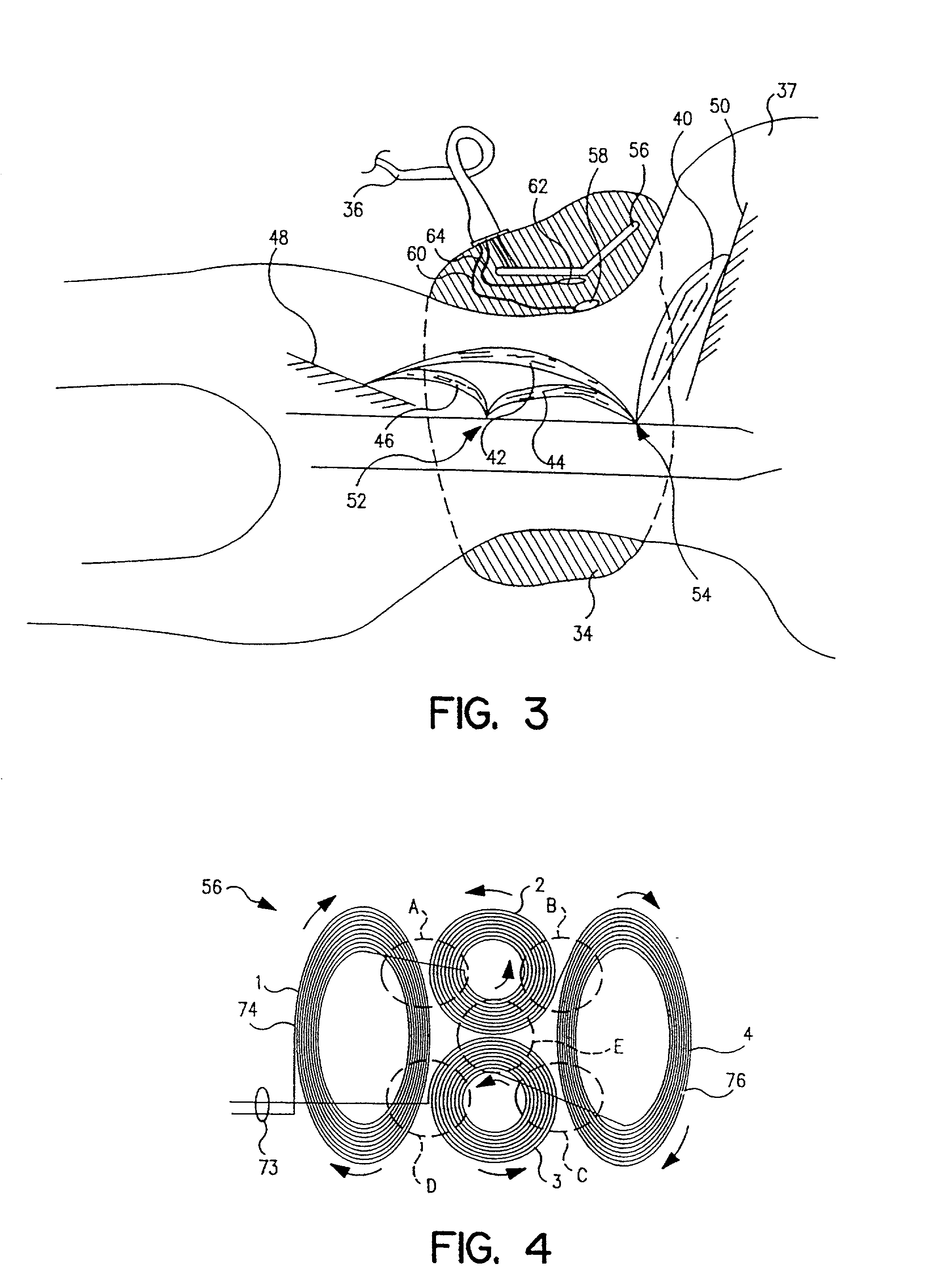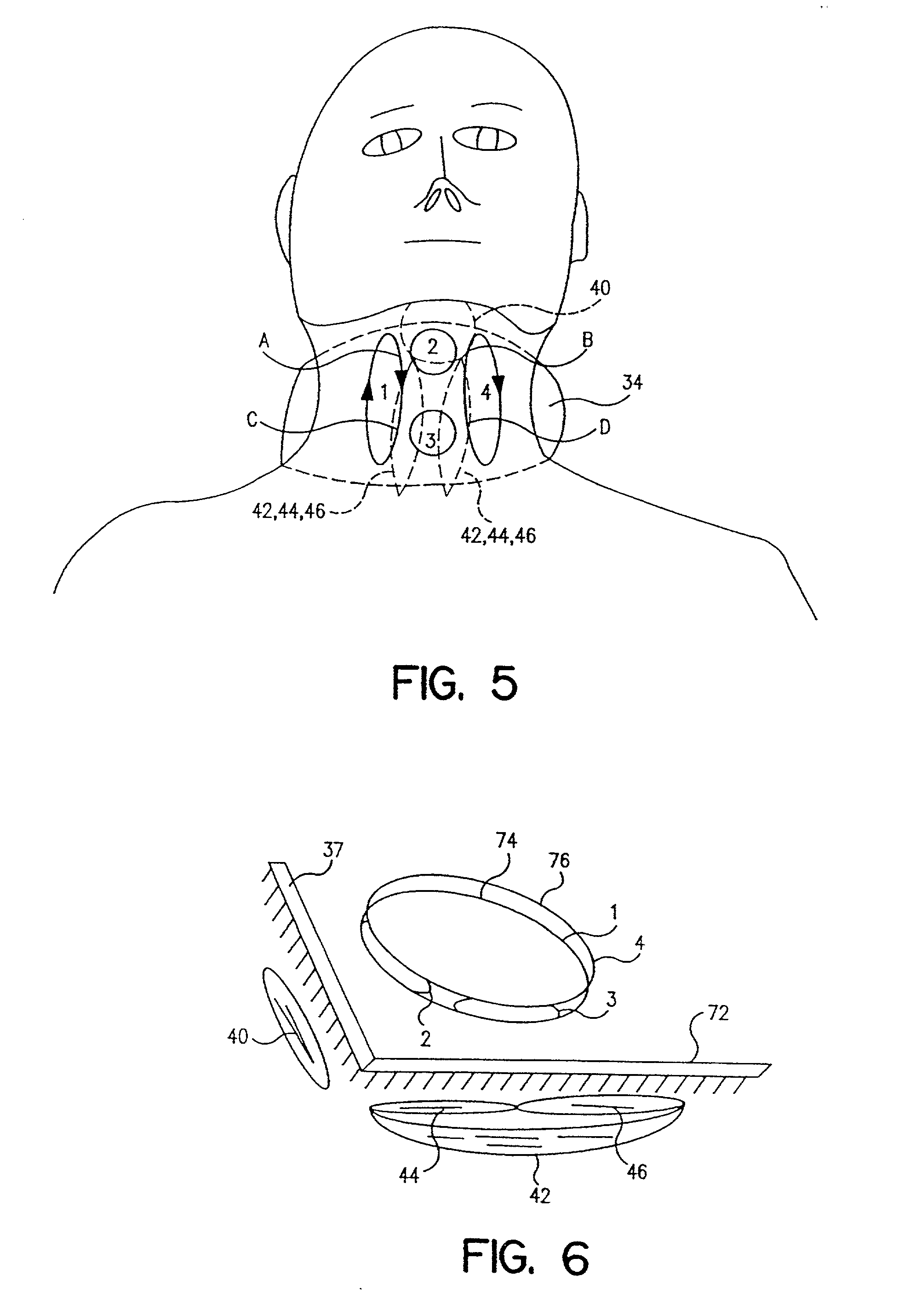Muscle stimulating device and method for diagnosing and treating a breathing disorder
a muscle stimulating device and breathing disorder technology, applied in the field of muscle stimulating devices and methods for diagnosing and treating breathing disorders, can solve the problems of hypersomnolent sleep apnea patients at risk for excessive mortality, sleep fragmentation and complete or near cessation, and severe degrees of oxyhemoglobin desaturation
- Summary
- Abstract
- Description
- Claims
- Application Information
AI Technical Summary
Benefits of technology
Problems solved by technology
Method used
Image
Examples
first embodiment
[0032] FIG. 1 illustrates a magnetic stimulator 30 according to the principles of the present invention. Magnetic stimulator 30 includes a control unit 32 and a collar 34 coupled to control unit 32 via a flexible cable 36. Collar 34 attaches to the patient's neck, as shown in FIG. 2, such that a portion 35 of collar 34 containing at least one magnetic field generating coil is disposed directly under the patient's chin 37. Control unit 32 receives signals from at least one sensor, such as sensor 38, which is connected to control unit 32 via a cable 39. Control unit 32 energizes the coil in collar 34 to produce a time varying electrical current that creates a changing magnetic field, whose rapidly increasing flux, in turn, creates a spacially varying electric field having a gradient that is maximized at specific muscles and / or muscle nerves in the upper airway. In short, the changing magnetic field produced by energizing the coil with a time varying current, such as a pulse train, ind...
second embodiment
[0060] A second embodiment for the coil used in the collar according to the principles of the present invention is shown in FIG. 7A. In this embodiment, six generally similar loops 82, 84, 86, 88, 90 and 92 define coil 80 with a current passing therethrough as indicated by the arrows. In the illustrated embodiment, loops 82, 84, 86, 88, 90 and 92 have the same number of turns and are wound from a continuous electrical wire. Because the loops in coil 80 are connected in series, a single pair of terminals 94 are all that is required to energize the coil. The coil configuration illustrated in FIG. 7A provides generally the same magnetic field pattern as the coil configuration illustrated in FIGS. 4-6. Namely, four magnetic field concentrations of generally uniform magnitudes are provided generally at areas A, B, C and D when a current is provided to terminal 94.
[0061] As noted above, the plurality of loops in coil 56 of FIG. 4 and in coil 80 of FIG. 7A are defined from a continuous wir...
third embodiment
[0062] As with the previous embodiments, four areas of increased magnetic field concentrations A-D are created by energizing loops 83a-83c and 85a-85c. Loops 83a, 83b and 83c have a common terminal 87, and loops 85a, 85b and 85c have a common terminal 89. As noted above, terminals 87 and 89 can be connected to separate power supplies, i.e., driven by separate currents, so that each group of loops is energized independently of the other, both in terms of timing and magnitude. Alternatively, terminals 87 and 89 can be connected together so that each group of loops receives the same current. This third embodiment of the coil simplifies the manufacture of the coil by enabling each group of loops to be made individually and combined to define the coil, thereby avoiding the relatively complicated winding pattern required to manufacture the coil illustrated in FIGS. 4 and 7A.
PUM
 Login to View More
Login to View More Abstract
Description
Claims
Application Information
 Login to View More
Login to View More - R&D
- Intellectual Property
- Life Sciences
- Materials
- Tech Scout
- Unparalleled Data Quality
- Higher Quality Content
- 60% Fewer Hallucinations
Browse by: Latest US Patents, China's latest patents, Technical Efficacy Thesaurus, Application Domain, Technology Topic, Popular Technical Reports.
© 2025 PatSnap. All rights reserved.Legal|Privacy policy|Modern Slavery Act Transparency Statement|Sitemap|About US| Contact US: help@patsnap.com



